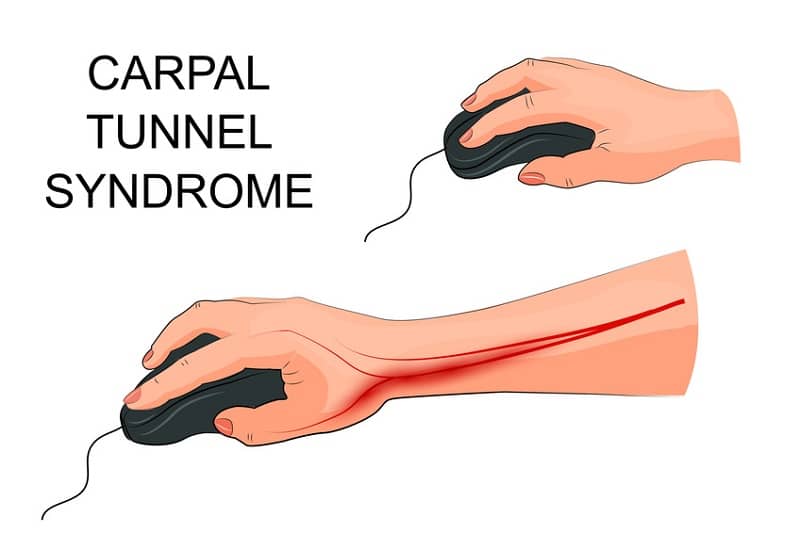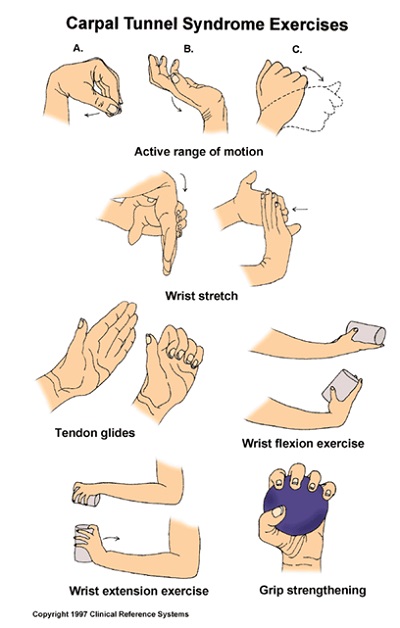


17 Sep Carpal Tunnel Syndrome (CTS): Symptoms, Risk Factors & Treatments
The nerve, namely the median nerve, is located inside the carpal tunnel. Inflammation causes swelling of the nerve leading to compression causing pain and tingling sensation accompanied by weakness in the hand.
This compression is because of the anatomy of the carpal tunnel which is formed of bones and ligaments and cannot change its shape.
The median nerve passing through it provides sensation majorly to:
- Thumb,
- index finger, and
- middle fingers
While carpal tunnel pain location mainly surrounds these areas, in the worst case of carpal tunnel, the pain and tingling sensation can also travel to the forearm.
Furthermore, if constant, this pain can cause problems in the gripping and or pinching movements of the thumb.
Though the direct cause of the compression of the nerve that leads to the medical condition is not known yet, the following factors can be held accountable.
What Causes Carpal Tunnel?
One of the major causes of carpal tunnel is extra pressure exerted on the median nerve located around the wrist.
It could either be because of swelling caused inside the tunnel or because of other factors like genetics and the intake of stimulants.
We discuss some of the most prominent causes of this neuropathic disorder in the following section.


Carpal Tunnel Causes Include:
#1. Heredity
In some people, the carpal tunnel is smaller than the rest of the population because of genetic factors.
This change in the anatomical structure of the carpal tunnel leaves little space for the nerve along with the 9 other tendons that are located inside it.
Hence, it causes excess pressure on the nerve leading to the neuropathic disorder causing pain and discomfort. The traits can run in the family.
#2. Repetitive Motions
Repetitive activities like gripping or vibration of the wrists and fingers can also cause the symptoms of the disorder and be among one of the leading causes of carpal tunnel syndrome.
This usually happens with people whose work requires such motions.
Initially, the symptoms start with a funny tingling in your fingers that can be easily resolved by moving your fingers back and forth.
But when this becomes constant for days, and then months, it finally culminates into the medical condition.
So…
What Type of Jobs Can Cause Carpal Tunnel Syndrome?
Jobs that involve extreme flexion or extension of the hands and wrists for a prolonged period of time can lead to the syndrome.
For example, a carpenter, sewer, driver, assembly line worker, or typist can be at risk of the syndrome.
#3. Hormonal Changes
Hormonal changes occurring around pregnancy can be responsible for the inflammation in the carpal tunnel.
This leads to compression around the nerve and causes inflammation leading to difficulty in the mobility of hands.
#4. Physical Injury
Anything that leads to compression in the carpal tunnel can irritate the median nerve leading to the syndrome.
For example, a physical injury like a wrist fracture can narrow the carpal space and cause compression around the median nerve.
#5. Medical Conditions
The following medical conditions can also be among the causes of carpal tunnel syndrome:
- Rheumatoid Arthritis – A chronic case of rheumatoid arthritis can give rise to the symptoms of carpal tunnel syndrome. Longstanding arthritis can cause the formation of spurs on the carpal bones that form the carpal tunnel compressing the median nerve. When the nerve gets compressed, it further leads to the syndrome causing pain.
- Gout – It is one of the rarest causes of carpal tunnel syndrome. Gout can result in the accumulation of tophi deposits in various regions like flexor tendons, tendon sheaths, the carpal tunnel floor, and even the median nerve. All of this can lead to the compression of the nerve causing CTS.
- Amyloidosis – The disease characterized by deposition of amyloid in various regions can lead to narrowing of the carpal tunnel by causing amyloid deposits on the tendons to be present inside the tunnel. This causes compression of the nerve.
- Tumour – Compression of the nerve because of a tumor is a rare case with less than 3% of such cases coming in every year. However, angiolipoma has been seen as an active compressive agent for the median nerve causing CTS.
- Ganglion Cysts – It mainly depends on the location of the cyst. If it’s around the wrist, it can interfere with the branches of the median nerves resulting in CTS.
Apart from all these causes, CTS (Carpal Tunnel Syndrome) can also be caused by making tight fists or keeping the wrist at extended positions, which can cause excess pressure on the median nerve.
Risk Factors of Carpal Tunnel Syndrome
Some prominent risk factors can increase the chances of people encountering the symptoms of CTS.
One such example is the higher risk percentage among women than men. The risk increases as women age.
Other risk factors might also include:
- Obesity
- Alcoholism
- Having fibromyalgia
- Hypothyroidism
- Fracture in the wrist
- Pregnancy
- Working jobs that involve the high extension of wrists
Despite such a high-risk percentage of CTS, people often fail to identify the signs of this condition and don’t receive the right treatment on time.
Hence, to make sure that you get the correct treatment, here is the list of symptoms you must look at whenever you have a prolonged tingling sensation in your hands.
Symptoms of Carpal Tunnel Syndrome



The following are some of the early symptoms of CTS (Carpal Tunnel Syndrome) you should be on the lookout for if you suspect you’ve got this condition.
#1. Numbness and Tingling Sensation
The initial symptoms of the syndrome start with a tingling sensation in the thumb, index finger, and middle fingers.
Though, in most cases, not all areas start showing the sign at the same time. They usually appear gradually, but in rare cases, there might be numbness all at once.
In mild cases, these symptoms might be transient like they might appear in the day and disappear at night.
#2. Dropping Objects
Gradually, the symptoms worsen and can vary from person to person.
In the cases of severe carpal tunnel, muscles at the base of the thumb and index fingers become weak and shrink in size.
Dropping things can be a sign of this weakness and the already present numbness.
#3. Discomfort in Wrist and Hands
The gradual onset of CTS can lead to pain and discomfort in the hand and wrist.
However, it’s not an initial sign of carpal tunnel syndrome and usually occurs post the tingling and numbness of the fingers.
With time, the pain might reduce along with the alleviation of numbness and tingling.
This pain and discomfort might just stay up to your hands and can radiate to your forearms.
However, it’s important to understand that when the discomfort reaches your hands, it is always recommended to visit a doctor as soon as possible.
Other Symptoms and Signs of Carpal Tunnel Syndrome
The above were only some of the common symptoms that appear when you are suffering from carpal tunnel syndrome.
However, there have been reports of people seeing other symptoms too including:
- Swollen fingers
- Weak pinch
- Waking up at night as the sensation in hands cause discomfort
- Fuzzy fingers
Although all these symptoms clearly hint towards CTS, self-diagnosis is not what we suggest when experiencing such signs.
These symptoms are mutual with some other symptoms which people often misdiagnose.
Two conditions that are often misdiagnosed as carpal tunnel syndrome are:
- Strain, and
- wrist tendonitis.
So, to get the right treatment, you must consult a doctor for the right diagnosis.
However, in less severe cases, there are also ways to manage the symptoms on your own no matter what are the causes of carpal tunnel syndrome.
How to Reverse Carpal Tunnel Syndrome Naturally?
The best way to relieve the symptoms of CTS is by indulging in physical exercises.
However, remember that these exercises can only help with the early stages of the syndrome and not in the later phases.
Exercises for Carpal Tunnel Syndrome



#1. Wrist Flex
Extend your arms in an outward direction with the palms facing towards the ceiling. Bend one of the wrists towards the floor and, with the other hand, flex this wrist back.
This creates a gentle stretch in the forearm. Hold the position for 15 to 30 seconds.
#2. Prayer Stretch
Keep the palms together in a prayer position at your chin level.
Now, lower the hands while keeping your palms in the same position and bring them close to the stomach to waist level for that extra stretch.
Perform the exercise for a set of two to four repetitions while holding the position for 15 to 30 seconds.
#3. Shake It Off
Give your hands a vigorous shake as if you are drying your hands in the air. This might help reduce the numbness and cramping.
Do this motion for a minute many times a day to keep your median nerve relaxed.
#4. Fist to Fan
Make a fist and try stretching your fingers as far as you can. Repeat this 5 to 10 times.
#5. Thumb Touches
Touch the tip of each finger with the tip of your thumb, one at a time to make an O shape.
Repeat this a few times.
#6. Wrist Resistance
Sit down and rest your forearm, wrists, and hand on a table while your palm faces down.
Lay your non-affected hand across the knuckles at a 90-degree angle to make a plus sign.
Now, lift the hand lying at the bottom up but resist it with the other hand on top.
Repeat this a few times a day.
Now, these exercises should offer some relief. But, as mentioned, not all cases are treatable with these.
In those not-so-mild cases where the discomfort is constant and you feel the pain growing, you must consult a doctor right away for a proper diagnosis.
Diagnosis of Carpal Tunnel Syndrome
An early condition of CTS can be transient, and just shaking your hands can relieve the symptoms irrespective of the causes of carpal tunnel syndrome.
But, with time, the numbness might not go away and cause irritation.
It might lead to less grip strength as gradually your muscles start shrinking with more pain and cramps.
Hence, it’s always better to get help in the early stages of CTS itself.
Diagnosis can be done in two ways:
- Physical examination
- Medical tests
#1. Physical Examination for Carpal Tunnel Syndrome
Before the diagnosis, your doc would consider your general health and medical history for a better evaluation.
Next, several physical tests help in careful examination of your wrists and hand.
Some of these tests include:
- Tapping the median nerve to check if it’s the possible cause of numbness
- Holding your arm in a flexed position to check for numbness in your hands
- Test for checking sensitivity in hands with the help of a particular instrument
- Weakness examined near the base of your thumb
- Examination of any signs of muscular atrophy in the base of the thumb
After this physical examination, there are tests conducted to check the functioning of the median nerve.
#2. Carpal Tunnel Syndrome Test
An electrophysiological test is conducted to confirm carpal tunnel as it determines the normal functioning of the median nerve.
It can also help the doctor evaluate the possibilities of any other nerve disorder.
These tests usually include:
- Nerve conduction studies – They evaluate the transmission of the signal through your nerves and detect if there is any interruption. It mainly helps in determining the severity of the condition.
- Electromyogram – It checks for the electrical functioning of your muscles.
Other tests that can be conducted for an analytical examination include:
- X-rays
- Ultrasound
- Magnetic resonance imaging scans
Once diagnosed and confirmed by a doctor, there’s a high possibility of treating and stopping the progression of CTS.
Treatment of Carpal Tunnel Syndrome
There are two types of treatments for CTS:
- Non-surgical
- Surgical
Treating Carpal Tunnel without Surgery
#1. Splinting
You can try wearing a brace or splint at night to prevent bending your wrist while sleeping.
This helps reduce the pressure exerted on the median nerve and reduces the symptoms.
Wearing the splint in the daytime can also help in doing activities that could otherwise have aggravated your symptoms.
#2. Non-Steroidal Anti-Inflammatory Drugs
There is a medication that can help to reduce the pain by reducing the inflammation of the nerve.
However, only take these medicines when prescribed by your doctor.
#3. Nerve Gliding Exercises for Carpal Tunnel Syndrome
Many exercises can help relieve the discomfort caused by CTS. But before you start with the exercises, remember that if any of the following exercises cause pain, take a break immediately.
Take the exercise slow and steady. Also, consult your doctor before starting with these:
- Bend your elbow and form a fist that faces you.
- Extend your fingers straight pointing up with your arm neutral and thumb tucked in.
- Now, bend your wrist in a position that your fingers point away from you.
- Extend your thumb in the outward direction and hold the position while turning the forearm away from you.
- Use the other hand to pull your thumb down for a more deep stretch.
- Repeat these three to five times.
#4. Steroid Injection
Anti-inflammatory injections are prescribed by doctors to help relieve the symptoms. But their effects are only temporary, and they are usually not for longer use.
Surgical Treatment of Carpal Tunnel Syndrome
When non-surgical methods don’t work, doctors usually recommend surgery.
However, that obviously depends on the severity of the symptoms – namely, the pain and numbness.
The surgery performed in such cases is called carpal tunnel release and increases the size of the tunnel to help relieve the pressure inside.
There are two types of the surgical process:
- Open carpal release
- Endoscopic carpal tunnel release
Now that we’ve covered every detail along with the main symptoms and causes of carpal tunnel syndrome, it’s time for a wrap-up.
The Outlook
There are many natural ways through which CTS can be treated.
However, when the symptoms don’t lessen with non-surgical or natural methods, surgeries are performed.
Just like all the other surgeries, this surgery can have its own complications. Some of these complications can include bleeding and infection.
But the doctors make sure that these complications are minimized and the outcome relieves your symptoms for the long term.
However, the entire recovery can take up to one year. In cases you have an underlying condition related to the wrists like arthritis, the recovery might be slow.
The immediate nature of carpal tunnel symptoms calls attention to visiting the doctor for early consultation before the condition worsens.
FAQs
This segment is an attempt at compiling the most recently asked queries related to carpal tunnel syndrome.
#1. Can you fix carpal tunnel without surgery?
Yes, many non-surgical methods can help improve the condition. Surgery is performed when the condition cannot be treated by any other method. Some of the popular non-surgical methods include exercises, medications, and injections.
#2. Is Squeezing a ball good for carpal tunnel?
Since CTS is a nerve-originated medical condition caused by compression of the median nerve, doing exercises like squeezing a ball won’t help.
It’s a structural disorder and needs specific exercises like nerve gliding exercises for treatment.
#3. Can you reverse carpal tunnel syndrome with exercise?
Yes, exercise programs are often suggested by doctors to treat CTS in milder stages. There are many specific exercises that can help you out including:
- Wrist flex
- Prayer stretch
- Fist to fan
- Thumb touches
- Wrist resistance
#4. What activities make carpal tunnel worse?
Here are some activities that can make CTS worse:
- Using your keyboard for a long duration of time, especially when your keyboard is in the wrong position.
- Working even after your hands are numb and painful
- Extending your wrist too much
- Performing exercises even when they are painful
#5. Is it OK to massage carpal tunnel?
Yes, massages can help relieve the symptoms of CTS. They help in reducing the pain, inflammation, and numbness. This is because a massage can lengthen the muscles.
#6. How do you stop carpal tunnel from progressing?
Here’s how you can prevent carpal tunnel syndrome from progressing:
- Reducing the force and relaxing your grip
- Taking breaks from repetitive works and motions
- Improving your posture
- Keeping your hands warm while working
#7. How should you sleep with carpal tunnel?
- Don’t bend your arms while sleeping; use splinting
- Support your arms
- Keep your hands on your arm
- Don’t sleep on your side
- Shake out your hands before sleeping
- Apply pressure on the wrists
- Take over-the-counter medications
#8. Does carpal tunnel cause swelling?
Yes, CTS is accompanied by swelling due to inflammation of the nerve caused by excess pressure on it. Sometimes, obstructed blood flow too can cause this swelling.
#9. Can carpal tunnel cause shoulder pain?
If the causes of carpal tunnel syndrome include a pinched median nerve at the wrist, the pain can radiate from the area towards the forearm and then the shoulder. This could even cause secondary pain around the neck.
#10. How long does carpal tunnel usually last?
Treatments can help relieve the symptoms like the tingling sensation and waking up at night within weeks or even days.
But symptoms like numbness can take a longer time to heal. If the diagnosis is wrong, the treatment might not be effective.
PEOPLE ALSO READ:
Loosen Stiff Lower Back Muscles: 10 Stretches for Instant Relief



No Comments